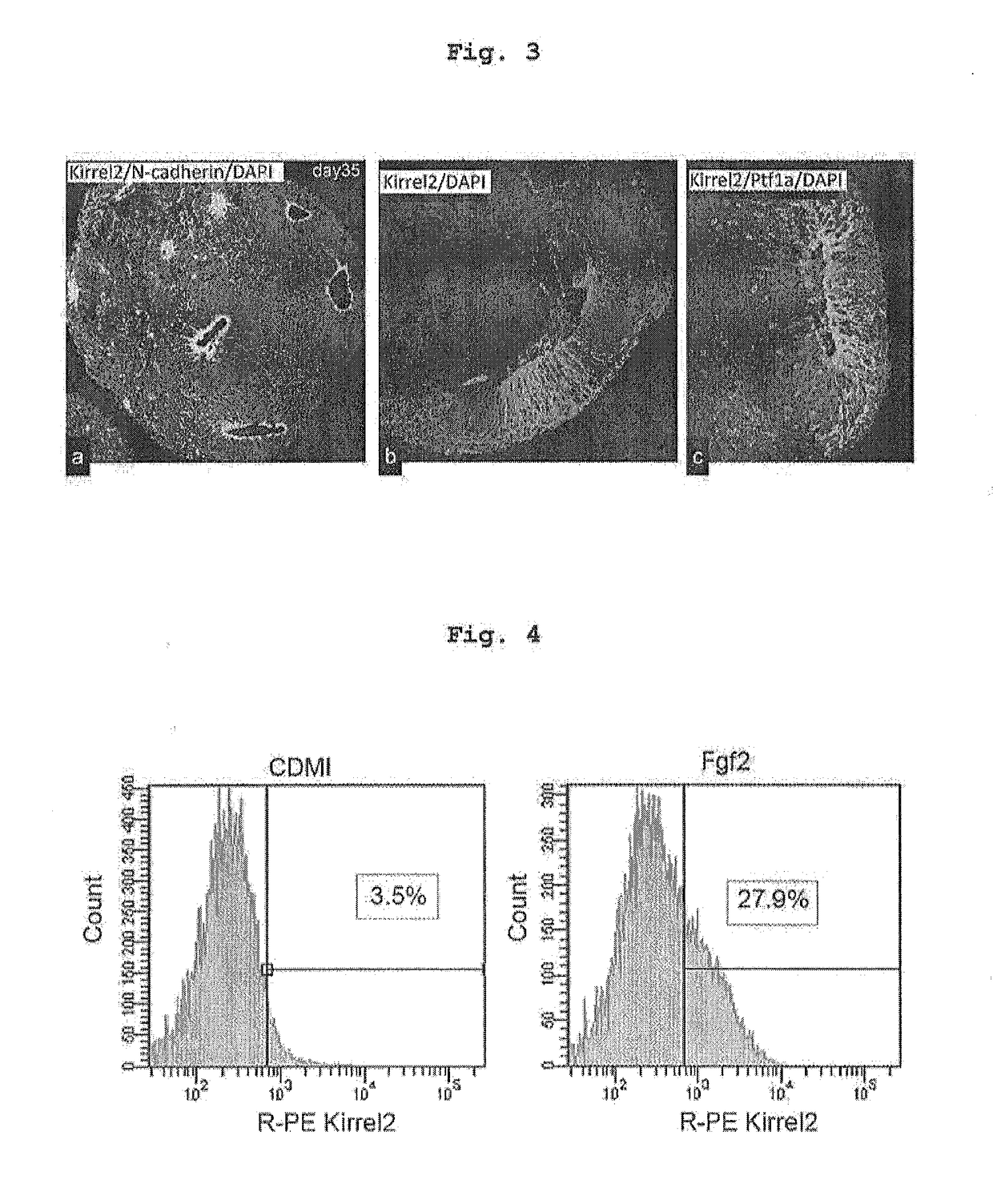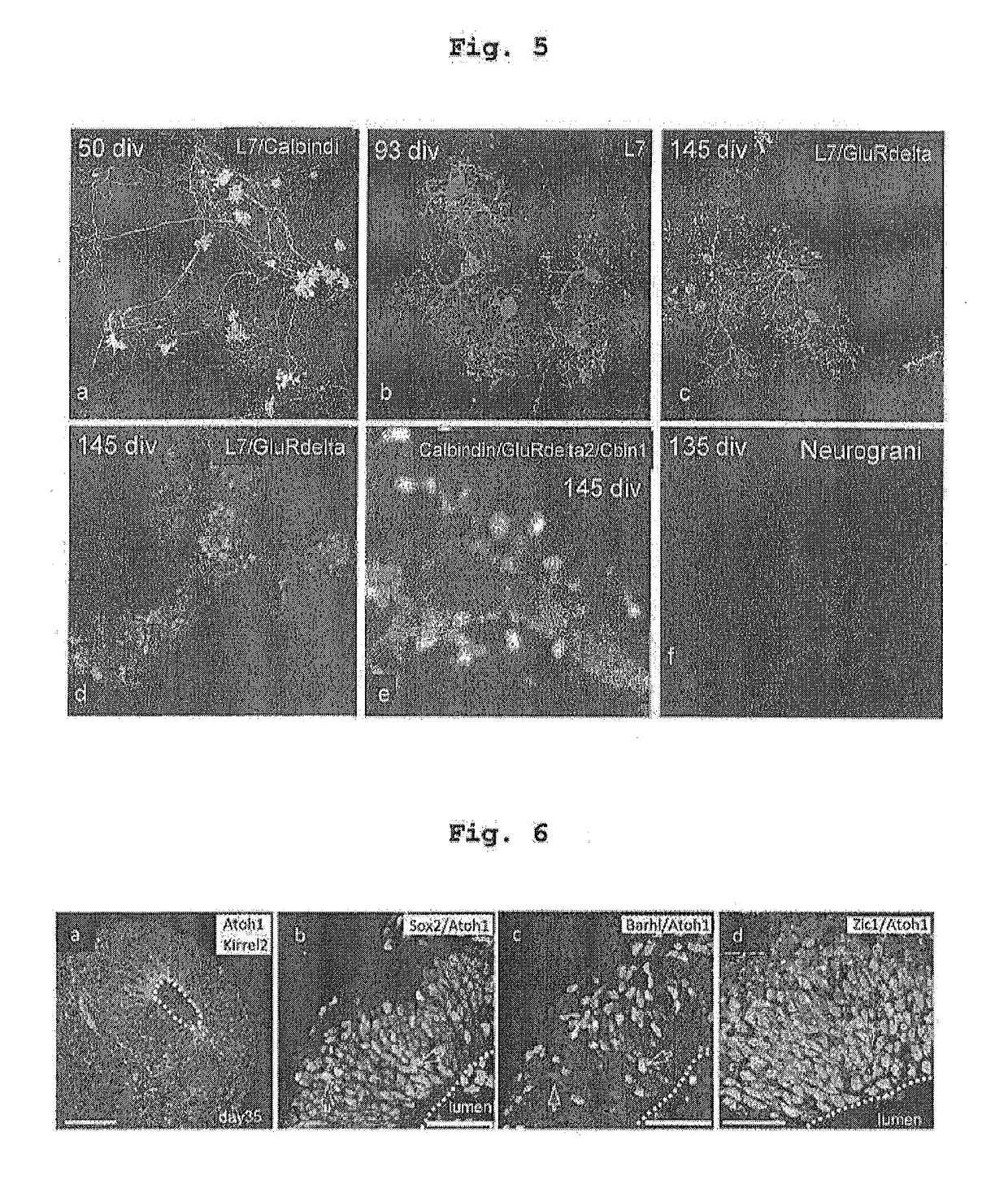Method for producing cerebellar progenitor tissue
a progenitor tissue and cerebellar technology, applied in the field of cerebellar progenitor tissue production, can solve the problems of largely elusive how the generated cellular components are assembled to form the intricate structure of the cerebellum, and achieve the effect of efficient induced
- Summary
- Abstract
- Description
- Claims
- Application Information
AI Technical Summary
Benefits of technology
Problems solved by technology
Method used
Image
Examples
example 1
[Example 1] Formation of Midbrain-Hindbrain Boundary Neural Progenitor Tissue from Human Pluripotent Stem Cell
(Method)
[0177]Human ES cells (KhES-1) subjected to maintenance culturing on MEF by a conventional method were used. To differentiate human ES cells by the serum-free floating culture of embryoid body-like aggregates with quick reaggregation (SFEBq method), human ES cells were enzymatically dispersed to single cells, according to the method of Nakano et al. (Cell Stem Cell, 10(6), 771-785, 2012), and reaggregated using a low-cell-adhesive V-bottom 96 well plate (SUMITOMO BAKELITE). 6,000 cells were seeded per well, and cultured in, as a differentiation medium, CDM medium [chemical synthesis medium without a growth factor (growth-factor-free Chemically Defined Medium; gfCDM; Wataya et al., Proc. Natl. Acad. Sci. USA, 105, 11796-11801, 2008) supplemented with insulin (7 μg / ml) and apo-transferrin (15 μg / ml)] under 5% CO2 at 37° C.
[0178]The seeding day is taken as day 0 of diffe...
example 2
[Example 2] Self-Formation of Cerebellar Plate Tissue Having Continuous Epithelial Structure from Human Pluripotent Stem Cells
(Method)
[0184]Human pluripotent stem cell aggregates were cultured according to the method of Example 1. The was aggregates were transferred to a low-cell-adhesion 10 cm dish on and after day 21, and cultured in a neural culture medium (Neurobasal / GlutaMaxI / N2, all Life Technologies). On day 28 of culturing, the total amount of the medium was exchanged with the same neural culture medium, and differentiation of the tissue was analyzed by the immunofluorescence method on day 35 of culturing.
(Results)
[0185]A plurality of N-cadherin positive neuroepithelial structures were formed in one aggregate, and not less than 70% of neuroepithelial cells were positive to cerebellar GABAergic neural progenitor-specific kirrel2 (FIG. 3 left, middle). Not less than 80% of the neuroepithelial structure expressing Kirrel2 also expressed GABAergic neural progenitor-specific Ptf1...
example 3
[Example 3] Differentiation of Purkinje Cell and Cerebellar Interneuron by Dispersion Culture of Human Pluripotent Stem Cell-Derived Cerebellar Plate Tissue
(Method)
[0188]Human pluripotent stem cell aggregates were cultured according to the methods of Examples 1 and 2, and Kirrel2 positive cells were separated by FACS using an antibody to cerebellar GABAergic neural progenitor marker Kirrel2 on day 35 of culturing. Separated Kirrel2 positive cells, and cerebellar granule cell progenitors prepared from the upper rhombic lip of embryonic day 14 mouse were dispersed into single cells by cell dispersion enzyme (TrypLE, Life Technologies), and cocultured on a cover glass coated with poly D-lysine / laminin in DMEM / F12 / 10% FBS medium (5% CO2, 37° C.). In coculture, human pluripotent stem cell-derived Kirrel positive cells (1 vol) relative to mouse-derived cerebellar granule cell progenitors (10 vol) were mixed. After 6-12 hr, DMEM / F12 / N2 / BSA / Tri-iodothyronine (T3) was added to decrease the F...
PUM
 Login to View More
Login to View More Abstract
Description
Claims
Application Information
 Login to View More
Login to View More - R&D
- Intellectual Property
- Life Sciences
- Materials
- Tech Scout
- Unparalleled Data Quality
- Higher Quality Content
- 60% Fewer Hallucinations
Browse by: Latest US Patents, China's latest patents, Technical Efficacy Thesaurus, Application Domain, Technology Topic, Popular Technical Reports.
© 2025 PatSnap. All rights reserved.Legal|Privacy policy|Modern Slavery Act Transparency Statement|Sitemap|About US| Contact US: help@patsnap.com



